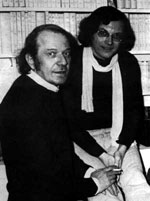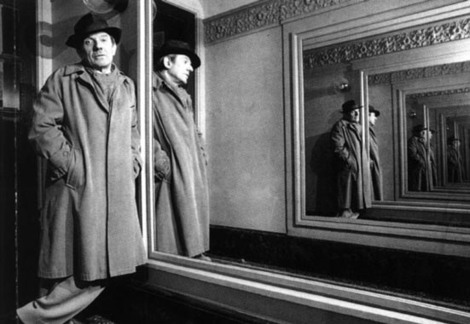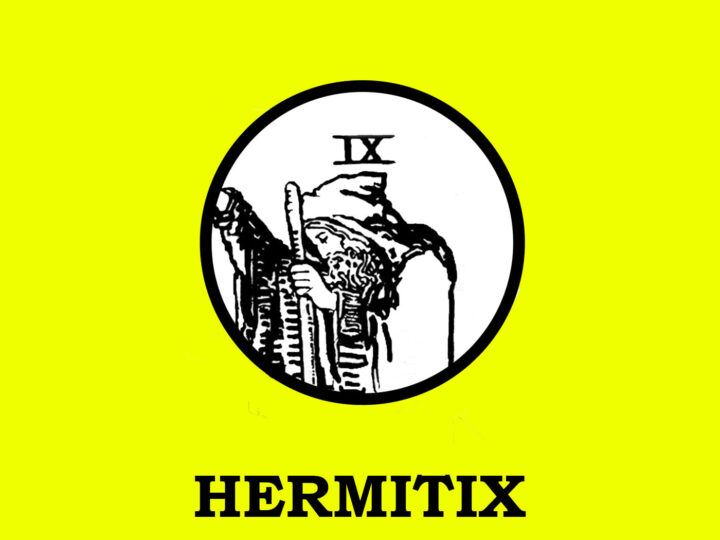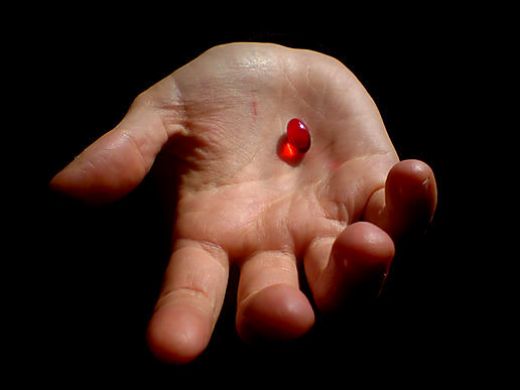
D&G’s “virtual philosophy”
Michel Foucault’s blurb is stamped on the back of What is Philosophy? like a slogan: “Perhaps one day this century will be known as Deleuzian.” Deleuze insisted that Foucault made the quip to amuse their fans and irritate their enemies, but it’s presence on the back of the latest Deleuze and Guattari translation indicates two things: One, that one senses something mighty in Deleuze, an epochal shift in the plate tectonics of thought. And two, that in America, a personal introduction from a more established friend doesn’t hurt.
Though a steady stream of translations over the last five years has scattered the spores, Deleuze (with or without Guattari) has yet to infiltrate American critical theory with the virulence of Foucault, Derrida, or Baudrillard. Though a small cottage industry is growing—appropriately worrying the wiser among them—there remains considerable resistance and apathy. Partly it’s because Deleuze and Guattari (or “D&G,” as they’re known on the Internet discussion group I belong to) keeps semiotics and its discontents at bay, partly because there’s plenty in his work to jerk the knee of those chronic skeptics who find things perennially—in that telling word “suspect”. For however much you pick apart the gears and chains of their conceptual apparatuses, finding this notion obscure and that notion problematic, at a certain point you gotta strap them on like a pair of fuzzy logic rollerblades. Those taught to prize criticism more than creation distrust this intensive hands-on approach, though artists and the congenitally weird seem to dig.
Even if D&G make their way into survey courses, it remains to be seen whether such dizzying schizos can ever fully be institutionalized. For there are many Deleuzes, some indistinguishable from various Guattaris. There’s the D&G of Anti-Oedipus, who marked a generation obsessed with Freud and Marx , and the D&G of A Thousand Plateaus, who marked a generation obsessed with Donna Haraway and cyberpunk. There’s Deleuze the SF mutant and Deleuze the high brow modernist, rhapsodizing Proust, Messiaen, and Pollock. There’s Deleuze the mad nomad, leaping with Guattari across multi-disciplinary fields at a single bound; and Deleuze the philosopher, a thinker who cannot be understood apart from the tradition that he decenters and perverts but does not abandon.
Though it buzzed the Parisians in 1991, What is Philosophy? by itself will probably not blow many minds. In many ways it’s a retrospective work, opening with the image of old men looking back and in some sense “ending” with Guattari’s demise in 1992. But What is Philosophy? intensifies if you connect it up to other relevant recent texts: all the Deleuze that has emerged the last couple of yearsincluding Difference and Repetition, the paperback edition of The Logic of Sense, The Fold: Leibniz and the Baroque, and Constantin Boundas’ The Deleuze Reader—and related documents like the translation of Lyotard’s Libidinal Economy, Zone’s most Deleuzian Incorporations and two great Deleuze studies by Brian Massumi and Michael Hardt.
Through its rippling investigation of mathematics, architecture and baroque monads, 1988’s The Fold is Deleuze at his most overtly fractal. But it’s The Logic of Sense and Difference and Repetition, highly original works that Deleuze penned in the late ’60s after writing studies of Nietzsche, Bergson, and Spinoza, that really throw down the man’s monstrous philosophical concerns: to build positive concepts without recourse to transcendent categories or the dialectic, to conceive pure difference while ignoring identity, to uncover the logic of those “untimely” and singular constellations of forces he calls “the event”. Besides providing the conceptual trampolines for Deleuze’s celebrated collaborations with Guattari on Anti-Oedipus and A Thousand Plateaus, these tomes engage two forces—virtuality and non-equilibrium dynamics—that are nowadays raging like banshees at thought’s door.
They’re also tough nuts to crack. With or without Guattari, the territories that Deleuze constructs are somewhat alien, and call for maps—or at least a compass that can handle the inter-dimensional pleats of non-Euclidean space. And while What is Philosophy? sums things up within a surprisingly conventional structure (“arborescent” as opposed to “rhizomatic,” to drop the talk), the language sticks too close to the folds to serve as an “overview.” Though an admirable attempt, The Deleuze Reader doesn’t do the job eitherwhile covering most of the bases (from rhizomes to Bacon, from cinema to Kafka), the bite-size chunks shorten the generous poetic breath that always infuses his work. And despite their excellent lucidity, both Brian Massumi’s A User’s Guide to Capitalism and Schizophrenia and Michael Hardt’s Gilles Deleuze: An Apprenticeship in Philosophy only confuse our image of Deleuze (perhaps productively). While unfurling the intensely pragmatic dimension of Deleuze’s seemingly arcane concerns, Massumi and Hardt speak in totally different tongues—Massumi employs a conversational tone, juicy analogies, and a pomo sensibility while Hardt traces the early Deleuze through the tight-ass philosophical lingo of substance and attribute, ontology and mode.
So is Deleuze a real philosopher or not? One is tempted to say that he is neither, that he is a virtual philosopher, diagramming the incorporeal zone that is, in Proust’s phrase, “real without being actual, ideal without being abstract.” But that still begs the question: what is philosophy?
Philosophy, Deleuze and Guattari say, is “the art of forming, inventing and fabricating concepts.” These intensive concepts, which in A Thousand Plateaus includes figures like the rhizome and the war machine, are composed on a “plane of immanence.” Huh?
To elaborate, we must enter the virtual: “Concepts are the archipelago or skeletal frame, a spinal column rather than a skull, whereas the plane is the breath that suffuses the separate parts…Concepts are concrete assemblages, like the configurations of a machine, but the plane is the abstract machine of which these assemblages are the working parts. Concepts are events, but the plane is the horizon of events…”
The heady dazzle of such language makes some folks just toss their books down, muttering about wacky frogs who have lost their politics. Others get really jazzed, and learn to mimic the lingo, a perhaps unavoidable superficial enthusiasm that critics of D&G point to as proof of their capitulation to nonsense. Forming a more rigorous engagement with this stuff is a difficult enterprise, because the work evades the categories we want to impose on it”metaphor,” “theory,” “fake science,” “hallucination.” Far from copping out, D&G are going for the gold: they want to re-engineer the nature of productive thought and the corresponding activity of bodies. Long ago, they grew sick of a society stuck in the habitual ruts of overcoded Oedipal subjectivity, State forms of organization, and cookie-cutter cut-outs of what a body can do. (Oedipus is one of these ruts, or but so is the micro-fascisms and redundancies that lurk in so many “radicalisms”). D&G introduce productive noise into the system—even and especially the system of theory—and from the inside they sometimes look like babbling loons. But they’re loons bearing gifts.
In What Is Philosophy?, the system is not so much the dominant grid of the State as such but the totalizing domination of market forces, advertising and the glib rhetoric of communication. “We do not lack communication. On the contrary, we have too much of it. We lack creation. We lack resistance to the present. The creation of concepts in itself calls for a future form, for a new earth and people that do not yet exist.” Knowing they sound cranky, D&G deplore “the general movement that replaced Critique with sales promotion” and makes “the simulacrum, the simulation of a packet of noodles…the true concept.” The dominance of information services and micro-marketing not only degrades art and philosophy, but produces a politics of cybernetic redundancy, of opinion polls and the dull feedback loops of consensus and groups that constitute themselves with a simple badge. What is to be done? “How could philosophy, an old person, compete against young executives in a race for the universals of communication for determining the marketable form of the concept?” Through last-ditch experiments, the creation of concepts that are “areolites”meteorites—rather than products, thoughts that come screaming in from the outside.
As Deleuze proclaimed in his introduction to Difference and Repetition, philosophy must be a kind of science fiction. The strange rhetoric and monster slang of SF estrange one from the historical inertia of the “now”, and allows a leap into “untimely” futures with their own singular self-consistency. SF also allows a rigorous yet hallucinogenic relationship with a scientific discourse D&G value without attempting to assimilate. “Philosophy can speak of science only by allusion, and science can speak of philosophy only as of a cloud.” They attack the scientific pretensions of cognitive philosophy, while mocking logic as “less like a game of chess, or a language game, than a television quiz game.” Yet by dipping into SF, they can extrapolate the conceptual imagination into a world transformed by science and technology. How do we conceive of being when the distinction between organic and machinic dissolves? When reality is folded into virtuality, the body morphs, and computer networks suck knowledge into a digital monad? How do we think if thinking is chaotic at its core?
Zone’s remarkable phone-book sized anthology Incorporations, which enacts one of the most vital mutations of contemporary theory, wraps all these questions up in a Deleuzian plateau built from brain science, film criticism, technological genealogies, and Spinozan ethics. And they couldn’t have done it without Deleuze and Guattari, who blasted themselves across the divide, and began lobbing back meteorites called “assemblages” and “abstract machines” and “bodies-without-organs”. How did they get there in the first place? Through the very (no)self-experimentations that their work seeks to inspire in its readers. “These measures belong to the order of dreams, of pathological processes, esoteric experiences, drunkenness, and excess. We head for the horizon, on the plane of immanence, and we return with bloodshot eyes, yet they are the eyes of the mind.” The resulting concepts are coherent and rigorous, but they do not begin with a desire to communicate or interpret or impose. “Thought itself is sometimes closer to an animal that dies than to a living, even democratic, human being.”
Clearly these techniques align D&G with artists as much as with scientists, extracting plotted points from the void. That’s why D&G don’t so much interpret or decode art as sample the forces it deploys. Though difficult, their chapter on art, “Percept, Affect and Concept,” is an often beautiful meditation on how painting and music and fiction build “houses” that filter, select, and compose cosmic forces, monuments that nonetheless open back into infinity. Not only are the artists they dig refreshingly un-postmodern (Melville, Woolf, Cezanne, Van Gogh, Boulez), some of them aren’t even human. They suggest that art begins with the animal who stakes out a territory, and cite one Australian rainforest bird that cuts leaves from trees and turns them over once they hit the ground so that their paler sides contrast with the earth. “It is a complete artist.” Besides complicating D&G’s usual valorization of “deterritorialization” over “territorialization,” this passage also demonstrates their ability to create a continuity between humanity and nature that does not reduce people to Darwinian statistics, but rather “raises up” nature into the ultimate zone of becoming.
Not coincidentally, it is in their discussions of art that D&G most overtly engage revolution and struggle. By speaking the “event,” the monument of art “confides to the ear of the future…the constantly renewed suffering of men and women, their re-created protestations, their constantly resumed struggle.” History is the cumulative inertia of bad habits, and the revolutionary force of collective experiment moves against internal as well as external enemies. “The success of a revolution resides only in itself, precisely in the vibrations, clinches, and openings it gave to men and women at the moment of its making and that composes in itself a monument that is always in the process of becoming, like those tumuli to which each new traveler adds a stone.”
For D&G, intensive politics, art, philosophy and science thus remain fundamentally experimental, cutting up chaos to compose what Joyce called a “chaosmos” — a composed chaos. Moreover, “the struggle with chaos is only the instrument of a more profound struggle against opinion, for the misfortune of people comes from opinion.” In their final chapter, D&G insist that the ultimate weapon is the brain, conceived as the junction of the three planes of philosophy, art, and science. D&G’s brain is not a meat computer, processing a noisy external world with Cartesian clarity, but is itself a total chaosmos. This is not so nutty as it sounds—among others, Incorporations-contributor and “real” neuroscientist Francisco Varela has recognized in thought and perception an emergent, collective, and bifurcating becoming. D&G do not close their book with the chaotic brain in order to usurp the authority of science, but to underline the concrete pragmatism of their SF theory. The interface between body and mind becomes an open system between two collectives, a fractal fold rather than a Cartesian split or an AI feedback loop. Who can say where it will lead, and what we will become along the way?
A version of this piece, some early writing from me on Deleuze and Guattari, appeared in the VLS




